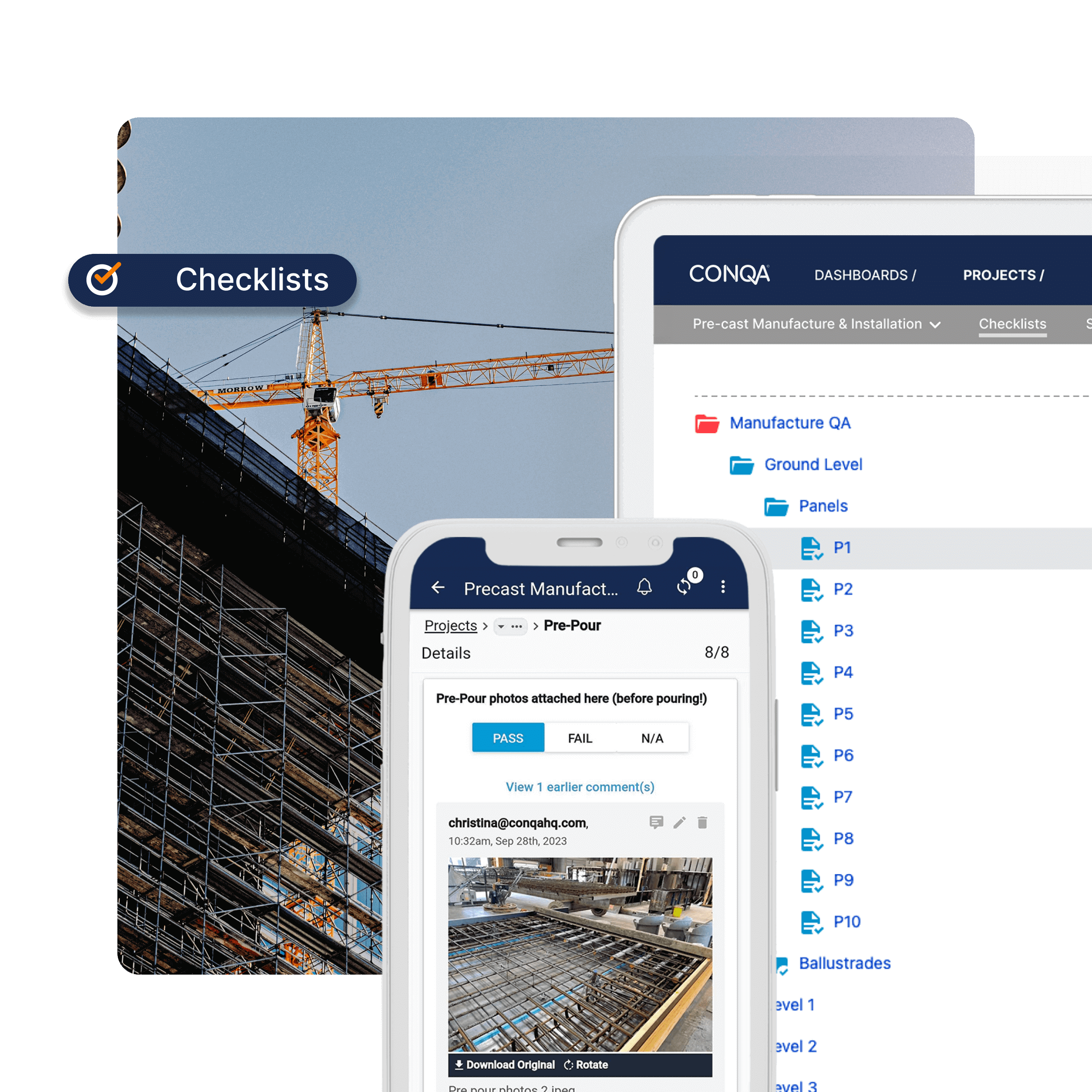Construction site efficiency: Mastering digital Checklists

The Evolution of Onsite Inspections
In the construction and engineering industries, onsite inspections have traditionally been a labor-intensive process. Those responsible for carrying out inspections relied on pen and paper to record observations, which often resulted in inefficiencies and inaccuracies and a large back of paperwork being completed after the project. These manual methods were susceptible to errors such as illegible handwriting, misplaced documents, and delays in information being added for relevant stakeholders. As technology advanced, the need for more efficient and reliable inspection methods became evident, leading to the advent of digital checklists.
Digital checklists have transformed the way inspections are conducted, offering a streamlined and systematic approach to data collection. By leveraging mobile technology, these digital tools allow inspectors to capture information in real time, enhancing the speed and accuracy of the inspection process. The transition from paper-based systems to digital platforms marks a significant change in the field, promising improved outcomes through better data management and communication.
Key Benefits of Digital Checklists
The adoption of digital checklists brings a multitude of benefits to onsite inspections. Firstly, they significantly improve data accuracy. With predefined templates and checkpoints, inspectors can ensure that no crucial information is overlooked. The ability to attach photos directly to checkpoints further enhances the reliability of the data captured, providing a visual record that supplements written observations.
Another key benefit is the efficiency gained through the use of digital checklists. The automation of data entry and the elimination of manual paperwork reduce the time spent on administrative tasks, allowing inspectors to focus more on their core responsibilities. Additionally, digital checklists facilitate seamless collaboration among team members. Information can be instantly shared and accessed by all stakeholders, fostering a more cohesive and informed team environment.
Furthermore, digital checklists offer unparalleled flexibility. Inspectors can create simple or comprehensive templates tailored to the specific needs of each project. This adaptability ensures that the inspection process is tailored to the unique requirements of different sites, enhancing the overall effectiveness of inspections.
Enhancing Team Engagement with Modern Tools
Modern digital checklists not only improve data capture but also boost team engagement. By providing a user-friendly interface, these tools empower onsite teams to take an active role in the inspection process. The accessibility of digital platforms ensures that team members can easily contribute their insights and observations, fostering a sense of ownership and accountability.
“We’ve had good uptake from the site teams and admin. It’s user friendly, the structure can
be changed to suit different types, and offers really good support".
Jonty Jones, Project Manager, AMP'T
Digital checklists facilitate real-time communication and collaboration. Team members can quickly share updates, raise concerns, and provide feedback, ensuring that everyone is on the same page. This collaborative approach enhances the overall efficiency of the team, as issues can be identified and addressed promptly, reducing the likelihood of rework and delays.
Incorporating digital tools into the workflow also creates opportunities for ongoing training and development. By integrating health and safety processes into digital checklists, teams can conduct regular toolbox talks, site visits, and incident reports. This continuous learning environment keeps team members informed and engaged, promoting a culture of safety and excellence.
Boosting Efficiency and Reducing Errors
Efficiency is a critical component of successful onsite inspections, and digital checklists play a pivotal role in achieving this goal. By digitising the inspection process, teams can eliminate double handling of data and streamline workflows. Information is captured once and stored securely, reducing the risk of errors associated with manual data entry.
“We built a checklist structure with CONQA which meant every element in every apartment was listed, and all the big trades
opted in to using this, which was really efficient as we were all working from the same platform,”
Dom Fleischl, Contracts Manager, CMP
Digital checklists also minimise the potential for human error. With structured templates and checkpoints, inspectors are guided through the inspection process systematically, ensuring that all necessary information is documented. The ability to work offline further enhances efficiency, as teams can continue inspections without interruption, even in areas with limited connectivity.
Site teams can quickly download and analyse key data points, gaining insights into project structure and performance. This data-driven approach enables teams to make informed decisions and continuously improve their processes, ultimately leading to higher quality outcomes.
Ensuring Accurate and Real-Time Data Capture
Accurate and real-time data capture is essential for effective onsite inspections. Digital checklists provide the tools needed to achieve this, allowing inspectors to record information instantly and with precision. The ability to attach photos and files directly to checkpoints ensures that all relevant data is captured and organised efficiently.
Real-time data capture also enhances the transparency and accountability of the inspection process. Stakeholders can access up-to-date information at any time, enabling them to monitor progress and address issues as they arise. This level of visibility is crucial for maintaining project timelines and ensuring that inspections are conducted to the highest standards.
Furthermore, digital checklists support comprehensive data analysis. By capturing detailed and accurate information, teams can identify trends, assess performance, and implement corrective actions when necessary. This proactive approach to data management ensures that projects are completed successfully and with minimal disruption.
In conclusion, digital checklists represent a significant advancement in the field of onsite inspections. By enhancing team engagement, boosting efficiency, and ensuring accurate data capture, these tools offer a powerful solution for modern inspection needs. Implementing digital checklists in your workflow can transform the way inspections are conducted, leading to better outcomes and a more streamlined process.
CONQA 30-Day FREE Trial
Construction field management software for contractors
Checklists | Sign-offs | Reporting | Variations | Progress tracking